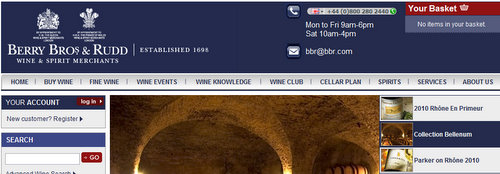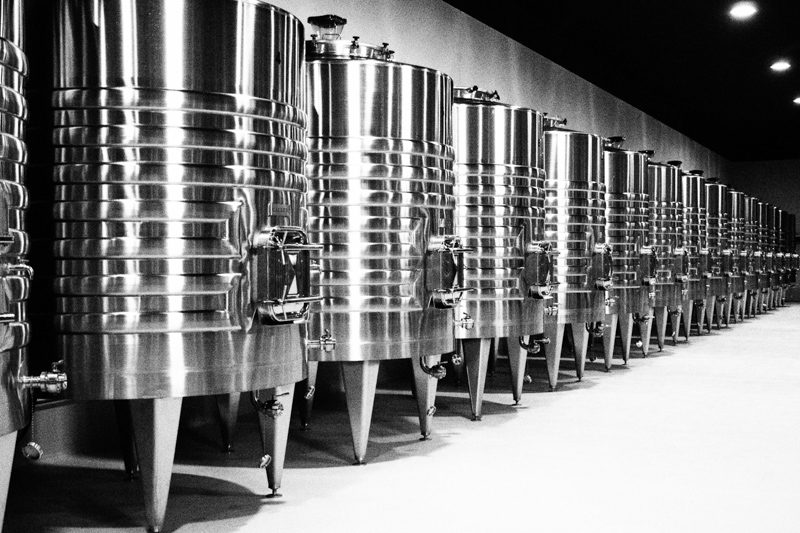Yesterday I was contacted by a brand consultant who is doing some work for a wine merchant. He wanted to pick my brains. The conversation got me thinking about brand management, and specifically the management of a wine retail brand.
Two of the strongest wine retailer ‘brands’ in the UK are Majestic and Berry Bros & Rudd. It is interesting to compare these rather different merchants.
Majestic is a category buster, with its distinctive out-of-town warehouse outlets, helpful staff, and informal shopping experience. It has done for wine retailing what IKEA did for furniture shopping: a stripped-down retail experience that customers actually find quite empowering.
Berry Bros & Rudd relates to the world through its wonderful shop at No 3 St James St. This is a wine merchant with a history. Yet they’ve managed to combine this image of a traditional fine wine merchant with a dynamic approach to online retailing. While BBR do sell some good, more affordable wines, their image and reputation is built around being a high-end, fine wine merchant with excellent customer service.
The challenge for both brands achieving growth outside their existing customer base.
For Majestic, the goal seems to have been to move more upmarket. While the core of the business is selling more accessible, affordable wines, it seems a shame to see the subset of your customers who buy fine wine go elsewhere when they’re picking up something more expensive, or buying en primeur. So Majestic began to sell fine wines, and then bought independent wine merchant Lay & Wheeler in 2009 in order to offer customers a full fine wine service, including bonded storage.
Moving upmarket like this doesn’t threaten the Majestic brand, because it is not immediately visible to the majority of customers. The distinctiveness of the Majestic brand is retained.
For Berry Bros & Rudd, the challenge is quite different. For them, two routes for serious growth exist. One is by brand extension downwards: selling more affordable wines to a wider customer base, building on their established reputation as an expert wine retailer. The other is to move in the other direction, and become a serious player in the international fine wine scene, selling the very best wines to high net worth individuals (HNWIs), with a focus on the growing band of HNWIs in emerging markets.
This latter expansion is already occurring, and reinforces the distinctive BBR brand. But what about extending the BBR brand downwards? This is much more dangerous. It risks losing brand distinctiveness. It would be a mistake to trade valuable brand equity for growth.
While it makes sense for BBR to build on its expertise as a wine retailer by reaching out to a new group of customers, this is best achieved by creating a new sub-brand. Think Abercrombie and Hollister. Protect the BBR brand as it is, and launch a new, associated brand with a different feel, targeting a new group of customers. There should be family resemblance—a focus on quality wines (not selling by promotion, or flogging soft brands) and a commitment to excellent service—but also some distinctiveness. BBR already have the logistical support, a long list of excellent agency wines (FMV, their agency arm, have been growing nicely in recent years), the web expertise, and the potential for considerable business overlap. What is needed is a new image, greater accessibility and a more modern feel. To change BBR along these lines would result in a loss of brand equity, but this can be avoided by creating a new, related brand.
12 Comments on Managing a wine retail brand: comparing Majestic and Berry Bros & Rudd



Good article, couldn’t agree more. Majestic seem to have a far easier job on their hands than BBR. I do think creating a new related company for BBR to access more affordable market is important- would be a fun job!
Two thoughts:
1) Something to be learnt here from the fashion world – look at the plethora of labels any one designer now has (think Giorgio Armani, Emporio Armani, Armani Jeans, Armani Exchange…) and you’ll see how one single brand can be extended to different audiences without corrupting the status of the original; and
2) Something to be learnt from second (and in some cases now, third) wines – Carraudes de Lafite doesn’t seem to damage the Lafite brand…
PS I hope you charged them for “picking your brains” – that’s what Americans call “consultancy”…
The Sediment Blog
How does BBR attract these customers without the leverage of the BBR brand? a new brand takes resource and time to build, perhaps in these tough economic times buying an existing but struggling lower end retailer offers a short cut. Much in the same way that Majestic bought Lay and Wheeler.
In addition, i think there is clearly an additional faceat to their strategy, with BBR integrating its business vertically e.g. buying richards walford. This will give them extra revenue channels as well as greater control from a supply perspective. Perhaps this is a good opportunity to freshen the Richards Walford brand so it that appeals across non tradtional BBR consumer channels aswell as existing trade channels? something done exceptionally well by Liberty wines.
I think that one of the major differences is that Majestic has heavily invested in a capillar presence all over UK, with nearly 200 shops (aiming for 300). That is not easily replicated by anyone who wants to follow the same route and it is a huge asset of the brand.
The other asset are the staff, higly educated on a mass scale (I think they have to have at least Advanced certificate of WSET and many study for the Diploma).
Interesting question – as a regular customer of both I’ve got some thoughts. If you were BBR you would have to seriously think about where you could make money at a lower level than their current position.
Majestic do it by an ostensibly no-frills, pile high approach to selling wine at enough of a premium to supermarkets that makes economic sense in areas that make demographic sense – given what has happened to Thresher, Victoria Wine, Oddbins over the past 15 years any other model seems to not generate enough revenue (value per bottle or volume) to work.
I reckon Majestic have very successfully tapped into the interested-in-wine sector that grew up with the likes of Oddbins’ prime in their university days in the 80s and 90s. They now have a car and enough of an ongoing interest in wine to go out and buy wine in bulk that the supermarkets for the most part (prob. excluding Waitrose) don’t satisfy.
Is there room for second Majestic? Is there room for a second IKEA? Hard to see. There’s certainly no room for a new Thresher or Oddbins. Maybe BBR should buy the Wine Society…
Patrick,
Good luck in getting those 250,000 Wine Society members to agree to that!
re. Buying the Wine Society. NOOOOOOOOO!
Why would Berry even contemplate your ideas? The profit margins on the wines they sell, even their own branded lines, would be much higher than Majestic. A brand like BBR demands that old marketing maxim “if it ain’t broke don’t try to fix it”. Your assumption is that all business need to grow by extending their customer reach or extending the brand or sub-brand. Marketing history is full of foolish strategies like this where brand lost their unique positioning and became basically meaningless to customers and were eventually overwhelmed by competition because someone had the bright idea to “grow sales” by wrong-headed strategies. BBR would be best to leverage what they do well now, not look at moving down-market in any shape or form. Anyone who has been in real marketing for years would probably tell you to stick to wine writing.
HNWIs? What marketing bullshit is this? ‘Rich people’ will do perfectly well. BBR has spent centuries selling wine to rich people and seems to be doing rather well. Chris R is absolutely right.
[There is definitely no room for a second IKEA- when another Scandie furniture firm tried recently they failed even before the recession)
Chris, I disagree.
Majestic’s margins are large. Their margins are protected during promotions by producers offering discounts, and even generic support.
Berry Bros are doing well now, but like any smart company they aren’t assuming that current performance predicts future performance.
They need to evolve in due course, and a company that decides it doesn’t want to grow can find itself in a dangerous position – it runs the risk of stagnating, where a maintenance attitude leads to a long, slow decline – slow enough that no one realizes it is happening until it is too late.
I’m suggesting here that (1) BBR protect their brand as it currently stands, but (2) seeks growth and reinvention through a sub-brand.
I think Berry’s can happily grow in line with the growth in rich and super-rich people. Were that trend to reverse, they’d be in trouble, but as it is they can probably get healthy growth just through maintaining share of the high net worth wine market which they should be able to do. (Mind you – there were some great bargains in their sale in January 2009 after the Lehman’s crash and the City imploded, so there are risks here).
remember that berrys have a huge and massively profitable (my guess) tasting / dinner / education / hospitality / enterainment business – that i dont think any other merchant in london comes even close to. that has been a brilliant initiative.